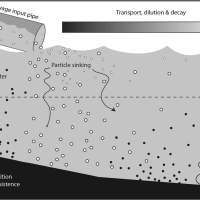Microbial Connections Between Water Quality and Air Quality

Aerosols originate from water and land surfaces and ultimately determine the quality of the air we breathe. Our lab looks closely at the microbial (fungal, bacterial, and viral) life populating the air in coastal areas. We study urban and rural sites, focusing on aerosol creation from waters experiencing sewage contamination, algal blooms, and other forms of microbial pollution. This work expands our understanding of inter-system microbial connections, since aquatic bacteria are moving to land in aerosols and vice-versa. This connection also serves to expand our appreciation for the importance of maintaining high levels of water quality, since what’s in the water can also be in our air.
Studying Coastal Aerosols' Microbial Life and Impact on Human Health
What are Aerosols?
Aerosols are tiny particles that are suspended in the atmosphere. These particles can be natural or anthropogenic and can be found in a variety of environments, including coastal regions. They can be solid or liquid and range in size from a few nanometers to several micrometers. The particles can be composed of organic and inorganic materials and can be formed through natural processes, such as volcanic eruptions, sea salt spray, and dust storms, or through human activities, such as industrial processes and transportation.
Sources of Aerosols
Aerosols can be found in a variety of environments, including coastal regions. Their sources of origin can be divided into natural and anthropogenic categories.
Natural Sources:
- Volcanic Eruptions: Volcanic eruptions can release large amounts of aerosols into the atmosphere, including sulfur dioxide, ash, and other particles. These particles can remain in the atmosphere for weeks or months, affecting air quality and climate.
- Dust Storms: Dust storms can generate large amounts of dust particles, which can be transported long distances and affect air quality in different regions.
- Sea Spray: The ocean is a major source of aerosols, with sea spray producing large amounts of salt particles that can affect air quality near coastal areas.
Anthropogenic Sources:
- Combustion: The burning of fossil fuels for transportation and energy production releases large amounts of aerosols, including particulate matter, sulfur dioxide, and nitrogen oxides, which can have negative impacts on human health and the environment.
- Industrial Processes: Industrial processes, including manufacturing and mining, can release aerosols into the air, contributing to air pollution.
- Household Sources: Activities such as cooking and heating can also release aerosols into the air, contributing to indoor and outdoor air pollution.
Microbial Life in Coastal Aerosols
Coastal aerosols are a specific type of aerosol that are formed when waves break on the shoreline. These particles contain a unique mixture of salt, water, and organic matter, including microbes. Coastal aerosols are of particular interest to scientists because they can be transported long distances by wind, potentially spreading microbial life across the globe.
Microbes found in coastal aerosols can include bacteria, fungi, viruses, and archaea. These microbes can have a range of impacts on human health and the environment, both positive and negative.
Importance of Studying Microbial Life in Coastal Aerosols
Studying microbial life in coastal aerosols is important for several reasons. First, these particles can spread microbes over long distances, potentially affecting human health and the environment in new ways. Understanding the microbial life in coastal aerosols can help researchers track the spread of diseases and identify potential sources of contamination.
Second, coastal aerosols are an important part of the global ecosystem. The microbes found in them can play a role in nutrient cycling, carbon sequestration, and other ecological processes. Understanding the role of microbes in coastal aerosols can help researchers better understand how these processes work and how they might be impacted by environmental changes.
Impact of Airborne Microbes on Human Health
Airborne microbes can have a significant impact on human health. They can cause respiratory infections, allergies, and other health problems. In some cases, they can also lead to more serious illnesses, such as pneumonia and tuberculosis.
The impact of airborne microbes on human health is of particular concern in coastal regions, where the concentration of aerosols is high. In these areas, researchers have found that people who live or work near the coast are more likely to suffer from respiratory problems and other health issues.
Inter-System Microbial Connections
Microbes play a vital role in maintaining the balance of various ecosystems, and inter-system microbial connections play a significant role in this regard. One example of such a connection is the transfer of bacteria from water bodies to the atmosphere through aerosols. Microbes living in water can be picked up by wind and transported into the atmosphere through the process of aerosolization. Once in the air, these microbes can interact with other microbes and impact the atmospheric ecosystem.
The role of microbial communities in atmospheric processes has been gaining increasing attention in recent years. For example, research has shown that airborne bacteria can influence cloud formation and precipitation. This is because some bacteria have properties that allow them to act as cloud condensation nuclei (CCN), which are essential for the formation of clouds. Additionally, microbes can interact with aerosol particles, altering their properties and affecting how they interact with other atmospheric components.
Impact of Water Quality on Air Pollution
Water quality can have a significant impact on air pollution. Microbial pollution in water can lead to the release of harmful microorganisms into the air. For example, fecal contamination in water can lead to the release of bacteria such as Escherichia coli, which can cause respiratory infections and other health problems when inhaled. Similarly, water pollution can lead to the growth of harmful algae blooms, which can release toxins that can be aerosolized and cause respiratory problems when inhaled.
In addition to releasing harmful microorganisms into the air, water pollution can also contribute to the formation of aerosols. For example, excess nutrients in water can lead to the growth of algae, which can then become aerosolized and contribute to the formation of airborne particles. Therefore, improving water quality is an important step in reducing air pollution and improving public health.
Factors Contributing to Microbial Pollution in Water
Microbial pollution in water can be caused by a variety of factors. One common cause is untreated sewage and wastewater. When sewage and wastewater are not properly treated, they can release harmful microorganisms into water bodies. Additionally, runoff from agricultural activities, such as the use of fertilizers and pesticides, can also contribute to microbial pollution in water.
Climate change is also expected to play a role in microbial pollution in water. Warmer temperatures can lead to the growth of harmful algae blooms, which can release toxins and contribute to the formation of aerosols. Additionally, changes in precipitation patterns can alter the flow of water, leading to the accumulation of pollutants and contributing to microbial pollution.
Conclusion
In conclusion, studying the microbial life within aerosols is a fascinating subject, and the findings presented in this lab report shed light on its importance. Understanding the sources of aerosols, the microbial life within them, and their impact on human health is crucial in developing effective strategies to reduce air pollution and improve public health. The inter-system microbial connections highlighted in the custom essays, as well as the impact of water quality on air pollution and the factors contributing to microbial pollution in water, are all crucial aspects of this study. By working to improve water quality and reduce microbial pollution, we can help protect the health of our planet and its inhabitants.
Relevant Publications:
“Onshore Wind Speed Modulates Microbial Aerosols along an Urban Waterfront”, Atmosphere, 2017.
“Challenges to Managing Microbial Fecal Pollution in Coastal Environments: Extra-Enteric Ecology and Microbial Exchange Among Water, Sediment, and Air”, Current Pollution Reports, 2017.
“Culturable bioaerosols along an urban waterfront are primarily associated with coarse particles“, PeerJ, 2016.
Relevant Research Activities:
Abstract accepted for manuscript in “Extreme Microbiology: the Atmospheric Biota” special section of Frontiers in Microbiology, 2017.
Session accepted for Association for the Science of Limnology and Oceanography (ASLO) Summer 2018 Meeting (Greg O’Mullan, Andy Juhl, Eli Dueker) — SS77: MICROBIAL EXCHANGE AND ECOLOGICAL INTERACTIONS AMONG SEDIMENT, WATER, AND AIR: EMERGING COMPLEXITIES IN MANAGING AQUATIC ENVIRONMENTS







